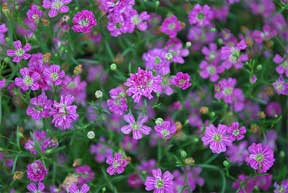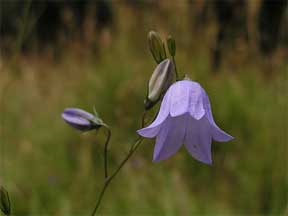If one has the time, the space and the inclination, growing perennial plants from seeds is the most inexpensive way to obtain a splendid and valuable assortment for landscape purposes and for a cutting flower garden.
Not all perennials will grow true to variety from seeds. Those that have been hybridized will vary more than seedlings from species. However, this variation is interesting and of considerable importance for it could be the start of some fine new varieties. Some seeds require hot weather for germination, others abundant moisture, and others may require a period of very cold temperature. Some varieties germinate easily when sown as soon as ripe, but have very slow or unsatisfactory germination when planted later.
Most perennial seeds can be sown outdoors in late winter and very early spring. This means any time from early March on, when the ground is frostfree and dry enough to be worked. What a help it is to the gardener to have the seeds in the ground before spring garden work becomes too rushed. Such plantings, as a rule, need little if any artificial watering.

The plants have fully two more months of growing time compared with June planting. Late frosts are seldom severe enough to be harmful to the little plants. They will often be large enough to reset before hot weather comes. Some of the more ambitious varieties may bloom the first year if weather conditions are favorable and the growing season not too short. For example in northwest Missouri, you can count on blossoms from achillea, anthemis, coreopsis, delphinium, gaillardia, lychnis, myosotis, platycodon, anchusa, formosanum lilies and pyrethrum the first season. Many perennials bloom the second year from seeds. One must wait three years or more for the slower ones to bloom.
Provide a Frame
A seed frame is essential for success. It can be much more easily protected from the elements, shaded and watered than when seeds are sown in rows in the open ground. A frame is so simple to construct that even a child old enough to handle a light hammer or drive a stake can build one. Four boards, six to eight inches wide, nailed together and/or staked in place, are needed to make a rectangular bed.
The frame may be any length desired, but the width should be a “comfortable reach,” around 30 to 32 inches, since you must reach across many times during the processes of planting, weeding, cultivating, and inspecting. Choose a sunny location in a spot convenient for watering and frequent inspection. If there is any question of good drainage, the bed should be built up several inches higher than the surrounding ground level. If one has a great many seeds to plant, several frames may be necessary.
Soil texture is important. Spade the bed to a depth of ten to 12 inches. Add a two-inch layer of humus in the form of compost or peat moss, and a half-inch layer of sand. Mix this well with the soil in the bed. If the soil is dry, use the sprinkling can or hose to saturate it to a depth of five to six inches before planting.
During wintry weather, for your own comfort, select warm, sunny days for planting. Use a board on edge to make rows four inches apart. Label with a marker each lot of seeds planted. Include date planted and source of seeds. Very large seeds may be planted about an inch deep; medium-sized ones a half-inch deep. Tiny seeds need only enough soil to cover them from sight. After the planting is finished for the day, sprinkle the rows gently with water and some type of shading material over the frame. Years ago people used burlap but today screen (maybe a few layers) can be used. A lath fastened to the front edge will hold it down.
Covering with Lath
A lath cover the same size as the frame is very convenient to have at hand. Space the laths their own width apart. The lath cover is used when the shaping material is pulled back. It admits shifting sun and shade which small plants like and at the same time keeps out dogs, cats and fowls.
The shading should be left on while the seeds are germinating. They will not all germinate at the same time, but by replacing the shading with the lath frame on a cool or cloudy day when most of the seeds are up the plants will not become leggy or spindly. Strips of screening may be placed directly on the soil over the rows that are slow to show germination. The strips must be removed promptly at the first signs of sprouting seeds.
The soil surface must be kept moist (but not soggy wet) while the seeds are coming up. If the rains fail, a sprinkling can or hose should be used, always gently, in order not to disturb the young plants. Attend to this during the morning hours to prevent damping off. After the plants are up, the rows can be mulched with partially decayed leaves to conserve moisture.
Perennial Variety Abounds
There is almost no end to the kinds of perennials that one can grow successfully from seeds. Columbines (aquilegia) are rather short-lived, but by planting seeds you can have dozens of plants to brighten the border or to cut. The long spurred hybrids may grow three feet tall and bloom in soft, lovely colors. Clematiflora hybrids, without spurs, may be blue, pink, rose, or white. There are dwarf varieties of columbines and fully double ones. If a plant opens exceptionally lovely blossoms, and you desire more, seeds may be allowed to develop, and those seeds planted in a frame just as soon as ripe. If moisture conditions are watched and the frame is kept properly shaded, they will germinate promptly and make fine plants before winter. Seeds can also be planted the following spring.
Delphiniums, too, are short-lived. It pays to keep seedlings coming on to replace the casualties. The seed loses vitality rather rapidly if it is not kept cool. The best germination occurs when new crop seed is planted as soon as mature. If this is not possible, quite satisfactory germination follows spring planting. In addition to the very large and tall hollyhock and hybrid strains, smaller delphiniurns are very desirable.
Members of the Campanula family come readily from seeds sown in early spring. Campanula glomerata, usually blue, but sometimes white, has blossoms packed in tight clusters at the top of the plant. Campanula persicifolia, up to 30 inches tall in blue or in white in both single and double varieties, is a general favorite. Campanula rotundifolia, the true Bluebells of Scotland, is shorter with showers of dainty bells on slender stems. Occasionally a plant with pure white bells will appear in a row of seedlings. Campanula rapunculoides is almost too willing to grow. Unless you have plenty of space, this one had better be eliminated, if it appears to grow too freely, and can become invasive.
Platycodon, the balloon flower, is a good germinator, and grows fast from early spring sown seed. A row of mixed seedlings will show most interesting and delightful variation in color blue, white, lavender, white with purplish veins, in both single and semi-double forms. One can also grow lovely shell pink ones from seeds.
Clematis in several varieties is another interesting plant to grow from seed. If there is a difference in Clematis recta and Clematis manchurica, I have not been observing enough to note it. Both grow three to four feet tall, bush form, and have fragrant white blossoms followed by seed clusters that are almost as showy as the flowers, Clematis integrifolia has similar seed clusters, but the spreading bells of rich blue are entirely different. Seeds of clematis vine varieties are available.
“Basket of Gold” alyssum (Alysrum saxatile) germinates best if seeds are sown as soon as mature. They may also be sown in early spring with good results. Painted daisies (pyrethrum) bring color to a garden and cut well. Plants from seeds are easy and supply these needs.
There always seems to be a need for more baby’s-breath plants to give a lacy effect to the border and to use as fillers in bouquets. Seeds are listed of several kinds. Gypsophila repens is low and long in bloom, white to blush-pink. Gypsophila paniculata is single white. G. Old/uzmimm blooms from August through October with clusters of white to pink tinted blossoms.
Oriental Poppies
Oriental poppies come easily from seeds. They will open gorgeous big blossoms in orange, scarlet, brilliant red, pink, and more rarely, white. The glaucum or horned poppies are treasured for their glaucous, lobed foliage both in the garden and in vases.
One can grow specimen plants of hardy hibiscus, the mallow marvel, from seeds. They are shrub-like in appearance with large flower-bowls in white, pink and crimson. Physostegia with white and lavender blossoms can boast of a host of common names – false dragonhead, lady of the lake, lion’s heart, obedient plant, and accommodation plant. It is a long lived perennial that is very satisfactory when grown from seeds both for garden use and to cut. Digitalis ambigua is a delightful perennial foxglove with soft yellow flowers marked with brown.

Dictamnus is commonly known as burning-bush, fraxinella, dittany, or gas-plant. Although it is rather slow growing, one feels well repaid for patience when its white blossoms appear. There is also a rose-colored variety. Add dictamnus to the list to be planted in the cutting garden.
You cannot go wrong trying hardy dianthus, the garden pinks the perfumed beauties from seeds. One can hardly feature a garden without shasta daisies, irises, feverfews, coreopsis, or gaillardias. Procure seeds of these, plant them carefully, and experience thrilling new gardening triumphs when the plants bloom.
Seeds are available of anchusas, thalictrums, verbascums, hardy sweet peas, yucca, helleborus (the Christmas rose), and veronicas. Do not hesitate to plant seeds of Tulipa dasystemon, scillas, and crocus. Your joy will know no bounds when your first seedlings of primulas, liliums, hemerocallis, eremurus (foxtail lilies), or penstemons bloom.
Do Not Forget the Natives
A splendid list of native plants can be grown from seeds – timber phlox (Phlox divaricata), Ruellia ciliosa, spiderworts, bluebells, (Mertensia virginica), Jack-in-the-pulpit, Missouri primrose, polemonium, baptisias, Thermopsis camliniana, Butterflyweed (Asclepias tuberosa) , and violets to name a few.
If some lots of seeds show no germination, it is well not to disturb the rows for at least another season. They may eventually come up. A number of the true lilies show no above ground growth until the second year, but little bulblets will be developing. Some failures are bound to occur. Be very slow to lay the blame on the seeds even if the seedsman’s suggestions for planting as printed on the packet or in his catalog have been faithfully followed. It is much more probable that something else interfered such as unfavorable moisture or temperature conditions. The seeds may have been planted too deep, or too shallow, or at the wrong time of year. Seeds of some varieties can be very temperamental. Let each failure be a challenge. Obtain another packet of seeds and try again!
